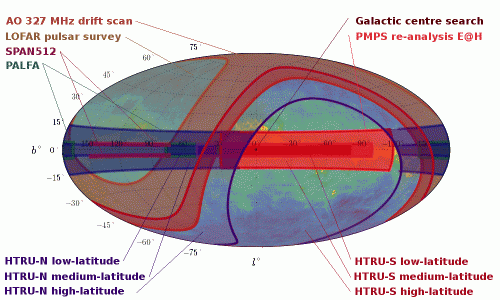
A schematic illustration of the Parkes radio telescope receiving the polarised signal from the distant fast radio burst FRB 140514, the first one to be discovered by astronomers in real-time. Image Credit: Swinburne Astronomy Productions
Detective novels aside, astronomy and astrophysics could well be considered as the next best occupation for anyone who loves an intriguing mystery. Similar to the investigative approach used for solving a crime, the scientific study of the Universe is more often than not a long and painstaking process of investigation, observation, and collection of evidence from many different lines of research, in order to narrow down the number of possible explanations for the cause of a cosmic phenomenon. One of these is the mysterious Fast Radio Burst, or “FRB,” which has been puzzling scientists ever since first being detected almost a decade ago.
As reported in an earlier AmericaSpace article, FRBs are very brief radio pulses which have been observed at various locations in the sky above and below the plain of the Milky Way galaxy. Even though they last only a few milliseconds, these enigmatic radio bursts nevertheless have an estimated energy output of up to several millions to billions of Suns during a single second, making them some the most energetic cosmic radio sources ever to be discovered. The first such detection of a FRB, which was made by the Parkes Radio Observatory in Australia in 2007, was originally met with skepticism by the scientific community, due to the transient nature of this enigmatic phenomenon. The lack of any follow-up observations of similar events in the immediate aftermath of this discovery made it difficult for astronomers at first to tell whether FRBs truly represented a new astrophysical phenomenon or were just the result of an instrument glitch on the radio telescope. The detection of a handful more such radio bursts in the years that followed ultimately helped to establish that these fleeting radio flashes had indeed a cosmic origin, leaving astronomers with a new intriguing mystery to solve.

An illustration of the various pulsar radio surveys that have been conducted through the years and their respective coverage of the sky, which have helped astronomers to discover the previously unknown phenomenon of the fast radio bursts. Image Credit: MPIfR, Ch. Ng
A limiting factor in the study of these ultra-powerful radio outbursts had been the fact that, up until now, they had all been accidentally discovered long after they had occurred, through the analysis of archival data previously gathered by radio telescopes through the years as part of systematic sky surveys for pulsars and other known cosmic sources of radio waves. A better understanding of the exact physical processes that powered FRBs clearly required more detailed observations, preferably as these events unfolded in real-time—a somewhat daunting task considering their apparent randomness. To that end, an international team of astronomers from Australia, the U.S., and Europe, led by Dr. Emily Petroff, a staff member at the Swinburne University of Technology’s Centre for Astrophysics and Supercomputing in Australia, undertook a comprehensive observing campaign in radio wavelengths in early 2014 of the regions in the sky where previous fast radio bursts had been discovered, in the hopes of detecting any similar follow-up events in real-time. By utilising the Multibeam Receiver on the 64-m Parkes Radio Telescope, which allowed them to scan many areas of the sky simultaneously, the researchers were able to conduct the first-ever such rapid, time-sensitive survey for FRBs, as part of a wider, multi-wavelength observing campaign in search of these enigmatic radio bursts.
The team’s efforts eventually paid off when the Parkes radio telescope detected a fast radio burst emission on 14 May 2014, at a high galactic latitude far from the plane of the Milky Way, which was located very near the position of a FRB that had been discovered back in 2011 in the direction of the constellation Auriga in the northern hemisphere. The great difference with all previously discovered FRBs was that the newly found burst, named FRB 140514, was detected just eight seconds after it went off, allowing Petroff’s team to track its progression in real-time. Less than a minute later, the researchers had already alerted various collaborative teams around the world, in order to conduct immediate follow-up observations throughout the electromagnetic spectrum, utilising a total of 12 ground- and space-based telescopes, including the 100-m Effelsberg Radio Telescope in Germany, the Gamma-Ray Burst Optical/Near-Infrared Detector in Chile, the optical 10-m Keck I telescope in Hawaii, and NASA’s Swift X-Ray Telescope, which were pointed toward the direction of FRB 140514 within several hours of its discovery. Yet, despite comprehensive searches which lasted until late July, scientists surprisingly found no afterglow or any other counterpart cosmic source that could be associated with the brief and elusive FRB. Despite having initially uncovered a couple of bright X-ray sources of interest with NASA’s Swift X-Ray Telescope that could potentially be linked to FRB 140514, astronomers soon realised after follow-up optical observations from the ground that these were just distant active galactic nuclei that happened to be along the same line of sight. “We observed in visible light and we could see that there were two quasars, that is to say, active black holes,” explains Giorgos Leloudas, a postdoc researcher at the University of Copenhagen’s Dark Cosmology Centre in Denmark and member of Petroff’s team. “They had nothing to do with the radio wave bursts, but just happen to be located in the same direction.”

The intensity profile of FRB 140514, showing how quickly it evolved in time, lasting only a few milliseconds. Before and after the burst, only noise from the sky was detected. Image Credit: Malesani/Petroff
The analysis of the emission from FRB 140514 showed that it shared a similar dispersion measure to the list of known fast radio bursts, indicating that its source was located far beyond the Milky Way galaxy. When radio waves are emitted by a cosmic radio source along our line of sight, they are dispersed by the ionised gas of the interstellar and intergalactic medium, which causes their lower frequencies to arrive on Earth later than their higher ones. This time delay in the arrival of the radio wavelengths is dependent on the electron density of the intervening ionised gas. The longer the delay, the greater the density of the intervening medium and the longer the distance that the radio waves have to travel to reach Earth. By measuring the dispersion of FRB 140514, Petroff’s team was able to calculate that the latter was up to 5.5 billion light-years away from Earth.
As to the exact physical processes that cause FRBs to flare up, there hasn’t been a lack of proposed theories among the scientific community, including cataclysmic supernova explosions, gamma ray bursts, colliding superconducting cosmic strings, evaporating black holes, the merger of rapidly rotating pulsars in distant galaxies, as well as the sudden flare up of extremely magnetized neutron stars, called magnetars—just to name a few. Nevertheless, the lack of any afterglow signals from FRB 140514 helps to eliminate several of the possible explanations. “In explosions such as supernovae (SNe) and superluminous supernovae (SLSNe), or in long gamma-ray bursts (GRBs), a counterpart is detectable as an object of varying brightness in subsequent observations,” writes Petroff’s team in their study, which was recently published in published in the Monthly Notices of the Royal Astronomical Society. “Variations in brightness would be observable on timescales of hours (for a long GRB), days (for typical SNe) or weeks (for a SLSN). Such variations were not seen in our data in X-ray, near-infrared, optical, or radio regimes. Additionally, no gamma-ray emission was observed by the interplanetary network (IPN) in either the hard or soft gamma-ray energy bands, ruling out all but soft, short gamma-ray bursts. Therefore, no variable counterpart or related transient emission was observed in association with FRB 140514.”
“We can rule out some ideas because no counterparts were seen in the optical, infrared, ultraviolet or X-ray,” adds Dr Simon Johnston, Head of the Astrophysics Department of the Commonwealth Scientific and Industrial Research Organisation (CSIRO) in Australia, which oversees the Parkes Radio Observatory. “However, the neat idea that we are seeing a neutron star imploding into a black hole remains a possibility.”
Theoretical speculation aside, however, the exact nature of these mysterious radio flashes coming from the distant Universe still remains unknown. “We still don’t know exactly what they are,” said Petroff during a public lecture at the 2014 MBO National Science Week, which was held last August at the Mount Burnett Observatory in Australia. “We have lots of theories and we’re all actively researching in this area, but really the important thing to do is to keep looking.” To that end, Petroff’s team will continue their observations in the coming years in the search of more FRBs, utilising the real-time detection technique that they have helped to develop. “These bursts were generally discovered weeks, months or even more than a decade after they happened,” says Petroff. “We are the first to catch one in real-time. We’ve set the trap. Now we just have to wait for another burst to fall into it.”
If the history of astrophysics research is any indication, then the solution to this real-life intriguing cosmic mystery will probably surpass anything conceived by even the most imaginative writer of the fictitious terrestrial ones.
Video Credit: Swinburne University of Technology
Want to keep up-to-date with all things space? Be sure to “Like” AmericaSpace on Facebook and follow us on Twitter: @AmericaSpace





